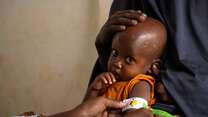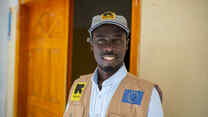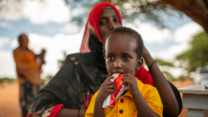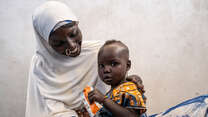Background
Malnutrition in South Sudan is omnipresent due to factors such as widespread disease (particularly malaria, diarrhea and pneumonia), poor health infrastructure and access to timely and effective treatment, prevalent non-recommended infant and young child feeding practices and inconsistent availability and accessibility to a diverse diet. In Aweil South County, the global acute malnutrition (GAM) prevalence remains above the national average and above the emergency threshold of 15% at 17.7%. A survey conducted by the International Rescue Committee (IRC) in Aweil South County showed that nearly 60% of severely malnourished children were not receiving treatment for severe acute malnutrition (SAM) through static facilities, with caregivers identifying the main barriers to accessing care as distance to facilities, inaccessibility due to the rainy season and high opportunity costs.
The IRC has been developing innovative approaches to increase access to treatment for acute malnutrition. Recognizing that long travel distance to facilities leads to high opportunity costs for caregivers, the IRC developed simplified tools and a simplified SAM treatment protocol to enable low-literate community-based distributors (CBDs) to treat children for malnutrition closer to the home. This included developing a modified mid-upper arm circumference (MUAC) tape with smaller color zones for monitoring progression, regression and stationary cases and a visual decal on the balance when weighing children to count out the number of sachets of ready-to-use therapeutic food (RUTF). Previous studies from Bangladesh have shown promising results with regard to how community-based models to treat SAM can be. However, models for low-literacy, crisis-affected settings have not yet been studied.
Study Objective
To assess the feasibility of community-based distributors in South Sudan providing treatment for uncomplicated cases of severe acute malnutrition in their homes.
Study Period
March - September 2017
Study Methodology
A total of 60 CBDs from four payams in Aweil South County were selected for training through simple random sampling. All selected CBDs were female, had no formal education, lived more than 5km from the nearest health facility and were accessible during the rainy season. After confirmation of distance from the health facility, three CBDs were excluded and fifty-seven CBDs remained to participate in a six-day training on the simplified tools and SAM treatment protocol. Immediately after training completion, CBDs participated in an assessment where they were evaluated on their performance of treating a SAM case using a standardized performance checklist. Only CBDs who scored higher than the a-priori determined cut off score of 80% qualified to pilot treatment in the community. Based on their performance scores, 44 CBDs were selected for study implementation.
Between March and September 2017, 44 CBDs admitted and treated 320 children with uncomplicated SAM between 6-59 months of age. Study staff conducted bi-weekly supervision visits during which they observed CBDs while they provided SAM treatment to admitted children. During each performance check, the study staff filled out a standardized performance checklist to monitor the CBD’s ability to correctly use the simplified tools and follow the simplified treatment protocol. Data on child progress and treatment outcomes were extracted from the patient register, including weekly MUAC measurement and the number of sachets of RUTF distributed per week.
Results
Performance scores calculated from the standardized checklist were collected for all 57 CBDs immediately following the training. The participants had a mean performance score of 94%, 91% of the participants passed at the a priori determined cut-off of 80% and 49% had a perfect score. For the 44 highest-performing CBDs selected for study implementation, the mean score dropped from 97% immediately after the training to 82% during the first supervised home treatment, but by the last supervised visit, the score had increased up to 94%. Of key CBD characteristics (CBD age, number of years working as CBD, performance checks conducted), only the number of performance checks had a statistically significant association with the performance score of the last supervisory visit completed (for each visit made, there was an increase in performance score of 2%).
The rate of children treated by CBDs that recovered from SAM to the moderate acute malnutrition (MAM) cut-off was 91%, surpassing the 75% Sphere standard and the remaining 9% defaulted. The median length of treatment among those who recovered to MAM was five weeks. The recovery rate of children that were admitted by CBDs for treatment from SAM to full recovery was 75%. The median length of treatment among SAM cases who recovered fully was 8 weeks. Fifteen percent defaulted and 9% did not respond after 16 weeks of treatment. No deaths were reported. Thirty-seven percent of children admitted were referred, the majority (94%) for a protocol safeguard that the study team added for children staying in one MUAC color for four consecutive weeks (as proxy for potential underlying health conditions). Twenty-nine percent of children admitted for CBD treatment fell into the more severe red MUAC zone (9.0 – 10.25 cm) on admission versus the pink MUAC zone (10.25-11.5 cm). A significantly lower proportion of admitted children were in the red zone at the outpatient therapeutic program during the same period.
Discussion
This study demonstrated that low-literate CBDs in South Sudan were able to treat SAM children in their homes with high accuracy using a simplified protocol and tools and achieve acceptable recovery rates. The performance scores were higher among those who received more supervision visits. The recovery rate for children enrolled in treatment met the Sphere humanitarian minimum standards despite treating children with lower MUAC on admission as compared to the facility, showing promise that deploying CBDs to treat SAM in areas with high prevalence and low treatment access may lead to earlier treatment seeking and timely case finding. Based on the percentage (84%) of children claiming to not have received treatment recently and the proportion of children with low MUAC on admission, we suspect that the CBD delivery of treatment increased access to timely care. A larger operational research study will be necessary to assess the most effective and efficient supervisory and supply chain mechanisms to operationalize the scale-up of CBD treatment and to quantify the cost-efficiency of such a program and its impact on access and coverage.



